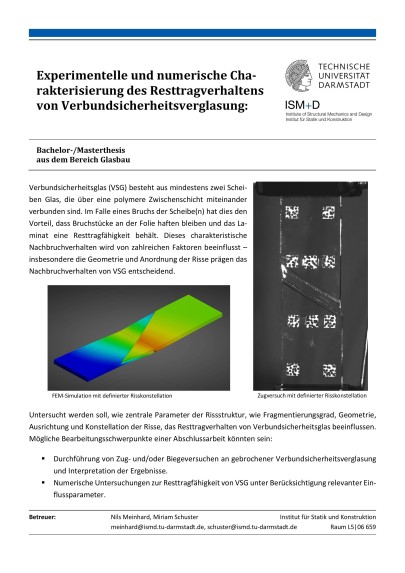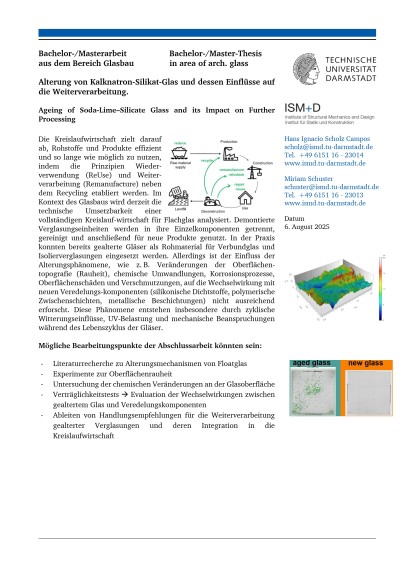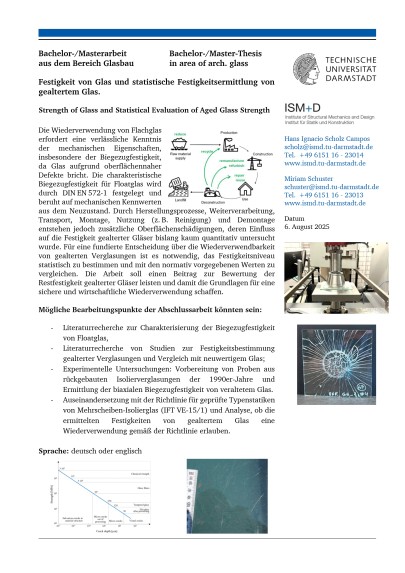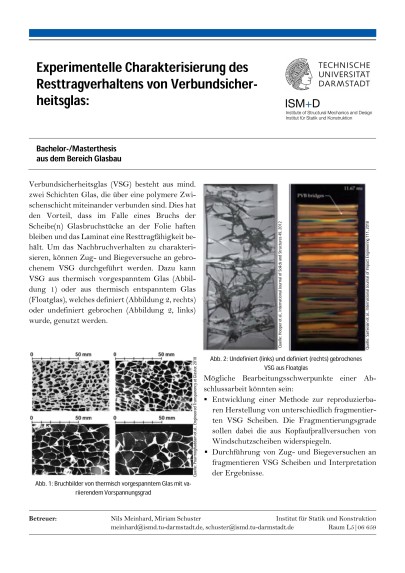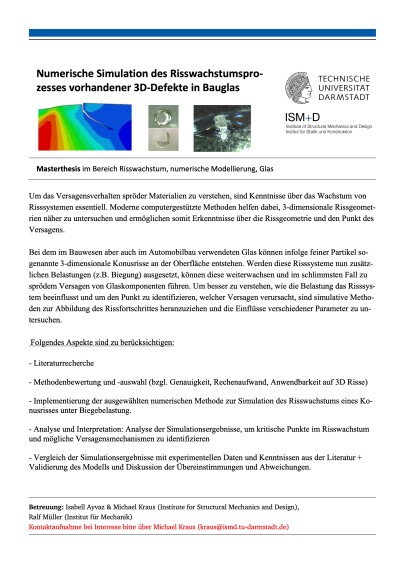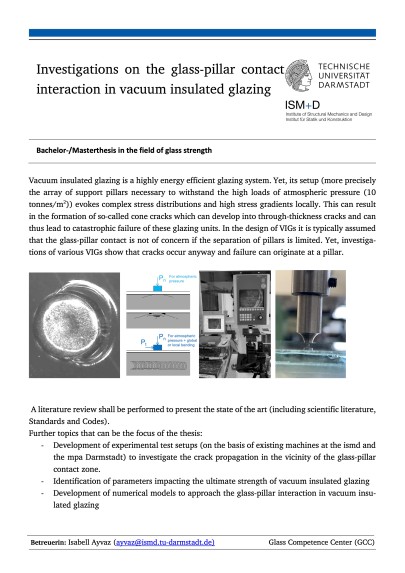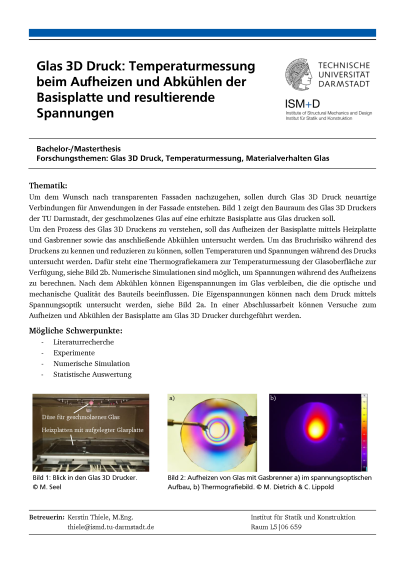Bachelor thesis, Master thesis
Laminated safety glass (LSG) consists of at least two glass panes that are bonded together by a polymer interlayer. In the event of fracture, this has the advantage that the glass fragments adhere to the interlayer, allowing the laminate to retain a residual load-bearing capacity. This characteristic post-fracture behavior is influenced by numerous factors – in particular, the geometry and arrangement of the cracks play a decisive role.
The aim of the study is to investigate how key parameters of the crack structure – such as the degree of fragmentation, geometry, orientation, and configuration of the cracks – affect the residual load-bearing capacity of laminated safety glass.
Supervisors: Nils Meinhard,, M.Sc., Dr.-Ing. Miriam Schuster
Ageing of Soda-Lime–Silicate Glass and its Impact on Further Processing
Alterung von Kalknatron-Silikat-Glas und dessen Einflüsse auf die Weiterverarbeitung
2025/08/06
Bachelor thesis, Master thesis
Context
A circular-economy approach seeks to extend the service life of resources and products by moving beyond traditional recycling towards reuse and remanufacturing. In architectural glass construction, this means dismantling glazing units, separating their components, cleaning them and upgrading them to new products. Recovered aged flat glass has already been used as a feedstock for laminated glass and insulating glazing units. However, the interaction of aged glass surfaces with new processing components — such as silicone sealants, polymer interlayers and metal coatings — has not been thoroughly investigated. Ageing phenomena such as changes in surface topography, chemical alterations, corrosion, surface damage and contamination occur due to exposure to weather cycles, UV radiation and mechanical loading throughout the glass’s service life. These changes may affect adhesion, durability and overall performance of new products manufactured from reclaimed glass. The aim of this thesis is to analyse these ageing mechanisms systematically and to assess their influence on the remanufacturing processes for aged float glass.
Possible topics for the thesis could include:
- Literature research on aging mechanisms of float glass
- Experiments on surface roughness
- Investigation of chemical changes on the glass surface
- Compatibility tests Evaluation of interactions between aged glass and finishing components
- Derivation of recommendations for action for the further processing of aged glazing and its integration into the circular economy
Languages: english or german
Supervisors: Hans Ignacio Scholz Campos,, M.Sc., Dr.-Ing. Miriam Schuster
Strength of Glass and Statistical Evaluation of Aged Glass Strength
Festigkeit von Glas und statistische Festigkeitsermittlung von gealtertem Glas
2025/08/06
Bachelor thesis, Master thesis
Context
Reusing flat glass requires reliable knowledge of its mechanical properties, particularly bending tensile strength, since glass fails at surface defects. The characteristic bending tensile strength of float glass is specified in DIN EN 572‑1 based on tests on new glass. Additional surface damage arising from manufacturing, processing, transport, installation, use (e.g., cleaning) and dismantling can significantly reduce the residual strength of aged glass. There is a lack of quantitative data on how ageing affects the strength distribution of reclaimed glazing. To make sound decisions on the structural reuse of aged glass, it is essential to determine its strength statistically and compare it with normative values. This thesis aims to contribute to the assessment of residual strength in aged glass panes, thereby providing a scientific basis for safe and economical reuse.
Possible topics for the thesis could include:
– Literature research on the characterization of the flexural strength of float glass,
- Literature research on studies to determine the strength of aged glazing and comparison with new glass,
- Experimental investigations: preparation of samples from dismantled insulating glazing from the 1990s and determination of the biaxial flexural strength of aged glass,
- Examination of the guideline for tested type statics of multi-pane insulating glass (IFT VE-15/1) and analysis of whether the determined strengths of aged glass allow reuse in accordance with the guideline.
Languages: english or german
Supervisors: Hans Ignacio Scholz Campos,, M.Sc., Dr.-Ing. Miriam Schuster
Bachelor thesis, Master thesis
Laminated safety glass (VSG) consists of at least two layers of glass bonded together by a polymeric interlayer. This has the advantage that, in the event of a breakage, glass fragments adhere to the interlayer, and the laminate retains residual load-bearing capacity. To characterize the post-breakage behavior, tensile and bending tests can be performed on fractured VSG. For this purpose, VSG made of thermally tempered glass or annealed glass (float glass), which has been broken in either a defined or undefined manner, can be used.
Possible focus areas for a thesis could include:
- Development of a method for the reproducible production of VSG panes with varying degrees of fragmentation. The fragmentation levels should reflect those observed in head impact tests on windshields.
- Conducting tensile and bending tests on fragmented VSG panes and interpreting the results.
Supervisors: Nils Meinhard,, M.Sc., Dr.-Ing. Miriam Schuster
Active Learning and Conditional Autoencoders
Innovative Approaches for Navigating Nonlinear Design Spaces of Multi-Story Structural Systems
2024/09/10
Master thesis
This master thesis develops AI-driven methods for design space exploration of multi-story frame structures, focusing on geometrically and material nonlinear behavior. The research implements active learning strategies and a conditional autoencoder tailored to structural engineering applications. Motivated by the need to efficiently navigate complex design spaces, the study considers nonlinearities, costs, and utilization rates in multi-story structures. By combining active learning for strategic sampling with a conditional autoencoder for dimensionality reduction and generative design, the thesis aims to create an intelligent framework for optimizing structural configurations. The findings are expected to provide insights into AI-driven design exploration in structural engineering, potentially transforming approaches to complex, nonlinear structural problems.
Supervisor: Prof. Dr.-Ing. Michael Kraus
Numerische Simulation des Risswachstumsprozesses vorhandener 3D-Defekte in Bauglas
Numerical simulation of the crack evolution of 3 dimensional defects in glass
2024/08/05
Software-Implementierung eines bruchmechanischen Modells zur Analyse der Parametersensitivität bzgl. der Festigkeitsminderung spröder Materialien
Software implementation of a fracture mechanics model to analyze the parameter sensitivity regarding the strength reduction of brittle materials
2024/08/05
Bachelor thesis, Master thesis
Vacuum insulating glasses (VIGs) are an innovative window technology with the potential to revolutionize energy-efficient buildings. Windows and transparent facade elements are the main sources of heat loss and CO2 emissions in buildings.VIGs consist of glass panes with a vacuum gap that minimizes thermal effects and improves the energy balance of building envelopes. Small spacers in the va- cuumed inter-pane space ensure stability over decades and significantly influence the behavior of VIGs. Investigation of this influence and the development of standards for the use of VIGs are crucial for the introduction of energy-optimized window and facade systems in Germany and Europe. VIGs could thus make a significant contribution to sustainability in construction.
Supervisor: Isabell Ayvaz, M.Sc.
2023/09/27
Bachelor thesis, Master thesis
Glass is a ubiquitous material in modern engineering applications, prized for its transparency, strength, and versatility. However, glass is inherently brittle, and its susceptibility to crack initiation and propagation poses significant challenges in structural and safety-critical contexts. Understanding how cracks propagate in indented glass specimens under subsequent loading is therefore critical for enhancing the safety and reliability of glass- based structures and products.
The outcomes of this thesis are expected to contribute to the knowledge base on glass fracture mechanics and safety assessment. Moreover, the findings may have practical implications for improving the design and perfor- mance of glass components in engineering applications, such as architectural glazing, automotive windshields, and electronic displays.
Supervisor: Isabell Ayvaz, M.Sc.
Bachelor thesis, Master thesis
While the glass panes in conventional lattice shells are typically used only as infill elements, activating the full load-bearing potential of glass can contribute significantly to reducing the material and energy resources of substructures for glass facades.
A current research project is investigating the integration of local and linear connection structures in glass supporting structures, which should help to better exploit the structural potential of the glass panes used and thus reduce the steel consumption in substructures to a necessary minimum. This should ultimately enable the construction of transparent glass structures with a wide variety of shapes and applications.
Supervisor: Isabell Ayvaz, M.Sc.
Bachelor thesis, Master thesis
Vacuum insulated glazing is a highly energy efficient glazing system. Yet, its setup (more precisely the array of support pillars necessary to withstand the high loads of atmospheric pressure (10 tonnes/m2)) evokes complex stress distributions and high stress gradients locally. This can result in the formation of so-called cone cracks which can develop into through-thickness cracks and can thus lead to catastrophic failure of these glazing units. In the design of VIGs it is typically assumed that the glass-pillar contact is not of concern if the separation of pillars is limited. Yet, investiga- tions of various VIGs show that cracks occur anyway and failure can originate at a pillar.
Supervisor: Isabell Ayvaz, M.Sc.
Bachelor thesis, Master thesis
Vacuum insulating glasses (VIGs) are an innovative window technology with the potential to revolutionize energy-efficient buildings. Windows and transparent facade elements are the main sources of heat loss and CO2 emissions in buildings.VIGs consist of glass panes with a vacuum gap that minimizes thermal effects and improves the energy balance of building envelopes. Small spacers in the va- cuumed inter-pane space ensure stability over decades and significantly influence the behavior of VIGs. Investigation of this influence and the development of standards for the use of VIGs are crucial for the introduction of energy-optimized window and facade systems in Germany and Europe. VIGs could thus make a significant contribution to sustainability in construction.
Supervisor: Isabell Ayvaz, M.Sc.
Bachelor thesis
In order to reduce the consumption of raw materials, the production of climate-damaging gases, and the generation of waste, the topic of the circular economy has been coming to the fore for some time. The circular economy is a holistic approach that aims to use raw materials and the resulting products efficiently and for as long as possible. It includes repairing, reusing and recycling.
Supervisor: Dr.-Ing. Miriam Schuster
2022/05/02
2022/04/19
Bachelor thesis, Master thesis
The aim of a current research project is to predict complex crack propagation during the glass breakage process as well as the resulting fragment geometry and size. To this end, ISM+D is creating a database from experimental studies in which glasses with different thermal toughness levels are broken in a targeted manner. The wave propagation in the glass body resulting from the impact is recorded with special sensors. The fracture pattern is analyzed by means of digital image processing.
Possible topics for a thesis (Bachelor or Master):
- Numerical characterization of fracture morphologies in thermally toughened glasses.
- Stochastic modeling of fracture morphologies in thermally toughened glasses
Supervisor: Dr.-Ing. Miriam Schuster
Bachelor thesis, Master thesis
To address the desire for transparent facades, glass 3D printing will be used to create novel joints for facade applications. Figure 1 shows the construction chamber of the glass 3D printer at the TU Darmstadt, which is to print molten glass onto a heated base plate made of glass.
To understand the process of glass 3D printing, the heating of the base plate using a hot plate and gas burner and the subsequent cooling will be studied. In order to know and reduce the risk of breakage during printing, temperatures and stresses during printing will be studied. For this purpose, a thermographic camera is available to measure the temperature of the glass surface, see Fig. 2b. Numerical simulations are possible to calculate stresses during heating. After cooling, residual stresses may remain in the glass, affecting the optical and mechanical quality of the component. The residual stresses can be studied after printing using stress optics, see Fig. 2a. Experiments on heating and cooling the base plate on the glass 3D printer can be carried out in a thesis.
Supervisor: Kerstin Thiele , M.Eng.
Bachelor thesis, Master thesis
Supervisors: Dr.-Ing. Miriam Schuster , Kerstin Thiele , M.Eng.
Breakage behavior of automobile windshields in pedestrian protection
External master thesis at Volkswagen in the field of strength of glasses
2022/01/25
Master thesis
Vehicle safety has the task of developing vehicles in such a way that accidents are avoided or the consequences of accidents are reduced as much as possible. In the field of pedestrian protection, so-called impactors are used to represent parts of the human body (head, hip and leg) and to assess the risk of injury in the event of a collision with the vehicle. The criteria and limits for assessing impactor load cases are defined and continuously developed by legislation (UN R 127) and consumer protection organizations (Euro NCAP). For example, the area of the windshield is newly included in the legal impact area and extended beyond the previous level for the Euro NCAP consumer protection test.
Further information, application requirements and documents to be submitted, etc. can be found here
Supervisor: Dr.-Ing. Miriam Schuster
Master thesis, Bachelor thesis
Laminated glass consists of at least two sheets of glass joined by a polymer interlayer. In the event of glass breakage, a residual load-bearing behavior occurs in which tensile stresses caused by bending are removed via the polymer interlayer. Numerical mapping of the material behavior of the interlayer in the case of large deformations, as occurs in the case of failure of one or more glass sheets, is currently not possible. The material behavior in this case depends on temperature and loading duration as well as on the magnitude of the load, so that nonlinear viscoelastic material models are necessary.
Supervisors: Dr.-Ing. Miriam Schuster , Kerstin Thiele , M.Eng.
Vakuumisolierglas – Technologie für eine energieoptimierte Gebäudehülle
Vacuum insulated glazing – A technology for an energetically optimized transparent building envelope
2022/01/13
Bachelor thesis, Master thesis
Vacuum insulating glazing (VIG) units are an innovative window technology that has the potential to revolutionize energy-efficient buildings. Windows and transparent façade elements are respon- sible for a large proportion of heat loss in buildings and therefore a large carbon footprint. A vac- uum insulation glazing consists of two or more glass panes between which a vacuum gap is created. This allows thermal effects to be minimized, thus optimizing the energy balance of the transparent areas of building envelopes. To ensure that the individual panes of the VIG can withstand the high stress of atmospheric pressure over several decades, small spacers are inserted into the vacuum gap as shown in the figure below. These are very small and, in addition to the edge seal which hermetically seals the VIG, have a decisive influence on the mechanical and thermomechanical behavior of VIGs. It is now exciting to investigate this influence and to develop implications for the normatively regulated use of the innovative glazing units in order to make a decisive contribution to the establishment of energy-optimized window and facade systems in Germany and Europe.
Supervisors: Isabell Ayvaz, M.Sc., Franz Paschke, M.Sc.
Entwicklung einer Methode zur Qualitätskontrolle bei Vakuumisoliergläsern
Development of a method for quality control of vacuum insulated glazing
2022/01/09
Bachelor thesis, Master thesis
Supervisors: Dr.-Ing. Henrik Riedel, Isabell Ayvaz, M.Sc.
Bruchzähigkeit bei steifen Klebern: Auslegung und Dimensionierung von Experimenten an Glaskörpern
Fracture toughness in stiff adhesives: Design and dimensioning of experiments on glass specimen
2021/12/21
Master thesis
The innovative and smart glass product eyrise®, based on liquid-crystal technology, can change its transparence and color within seconds. The edges of the glass panes are sealed with a stiff polymeric adhesive. The employed adhesive layers are thin and thereby shear resistant while simultaneously providing a high adhesion between the two adherends. Due to the geometry of the adhesive layer and the requirements of later numerical investigations, two experimental setups are to be dimensioned. By those means, the fracture toughness for both crack opening mode I and II are to be determined while the similar strength of adhesive and adherends have to be considered.
Supervisor: Dr.-Ing. Florian Rheinschmidt
Folienkissen aus Dünnglas
Thin glass foil cusions
2021/12/09
Numerische Simulation der thermisch induzierten Spannungen von Fassadenverglasungen
Numerical simulation of the thermally induced stresses of facade glazing
2021/03/29
Numerische Untersuchungen zum thermisch induzierten Glasbruch beim Doppelringbiegeversuch bei hohen Temperaturen
Numerical investigations on thermally induced glass fracture in the coaxial bending test at high temperatures
2021/03/29
Institut für Statik und Konstruktion

Glass Competence Center
Glass Competence Center
The content of this page is only available in German.
Please go to German version of this page



